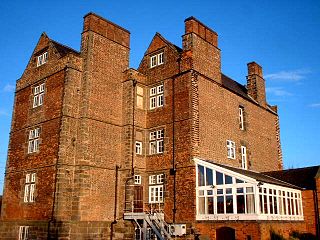
Chellaston is a suburban village on the southern outskirts of Derby, in Derbyshire, England.

The Derby Canal ran 14 miles (23 km) from the Trent and Mersey Canal at Swarkestone to Derby and Little Eaton, and to the Erewash Canal at Sandiacre, in Derbyshire, England. The canal was authorised by an Act of Parliament in 1793 and was fully completed in 1796. It featured a level crossing of the River Derwent in the centre of Derby. An early tramroad, known as the Little Eaton Gangway, linked Little Eaton to coal mines at Denby. The canal's main cargo was coal, and it was relatively successful until the arrival of the railways in 1840. It gradually declined, with the gangway closing in 1908 and the Little Eaton Branch in 1935. Early attempts at restoration were thwarted by the closure of the whole canal in 1964. Since 1994, there has been an active campaign for restoration spearheaded by the Derby and Sandiacre Canal Trust and Society. Loss of the Derwent crossing due to development has resulted in an innovative engineering solution called the Derby Arm being proposed, as a way of transferring boats across the river.

Weston-on-Trent is a village and civil parish in the South Derbyshire district of Derbyshire. The population of the civil parish at the 2011 census was 1,239. It is to the north of the River Trent and the Trent and Mersey Canal. Nearby places include Aston-on-Trent, Barrow upon Trent, Castle Donington and Swarkestone.
Swarkestone is a village and civil parish in the South Derbyshire district of Derbyshire, England. The population at the 2011 Census was 187.

Morley is a village and civil parish within the Borough of Erewash in Derbyshire, England.

Twyford and Stenson is a civil parish in the South Derbyshire district of Derbyshire, England. Located south of Derby on the Trent and Mersey Canal, it consists of two villages, Stenson and its smaller neighbour Twyford.

The Melbourne Line was a railway line which ran from Derby to Ashby de la Zouch. It was used by the British Army and Allied engineers during the Second World War from 1939 until late 1944 to prepare them for the invasion of mainland Europe. Engineers practised the demolition and rebuilding of railways and the running and maintenance of a railway line and its rolling stock. There was also a bridge building school at Kings Newton.

Anchor Church is the name given to a series of caves in a Keuper Sandstone outcrop, close to the village of Ingleby, Derbyshire, England. The caves have been extended by human intervention to form a crude dwelling place, complete with door and window holes.

St Michael's Church, Stanton by Bridge is a Grade I listed parish church in the Church of England in Stanton by Bridge, Derbyshire.

St Wilfrid’s Church, Barrow upon Trent is a Grade I listed parish church in the Church of England in Barrow upon Trent, Derbyshire.

St Mary the Virgin's Church, Weston-on-Trent is a Grade I listed parish church in the Church of England in Weston-on-Trent, Derbyshire.

All Saints’ Church, Aston upon Trent is a Grade I listed parish church in the Church of England in Aston-on-Trent, Derbyshire.

St James’ Church, Swarkestone is a Grade II* listed parish church in the Church of England in Swarkestone, Derbyshire.

St Bartholomew's Church, Elvaston is a Grade I listed parish church in the Church of England in Elvaston, Derbyshire.

St Andrew’s Church, Twyford is a Grade I listed parish church in the Church of England in Twyford, Derbyshire.

St James’ Church, Shardlow is a Grade II listed parish church in the Church of England in Shardlow, Derbyshire.

The Bailey Bridge is a crossing of the River Trent at Walton-on-Trent on the border of Derbyshire and Staffordshire in England. The bridge is only one lane wide with access controlled by a tidal flow system controlled by signals at either end of the bridge. A separate footbridge is attached to the northern side of the structure.

This is a list of scheduled monuments in the district of South Derbyshire in the English county of Derbyshire.
Stanton by Bridge is a civil parish in the South Derbyshire district of Derbyshire, England. The parish contains twelve listed buildings that are recorded in the National Heritage List for England. Of these, two are listed at Grade I, the highest of the three grades, and the others are at Grade II, the lowest grade. The parish contains the village of Stanton by Bridge and the surrounding area. The listed buildings consist of a church, a bridge and causeway, houses and associated structures, farmhouses and a farm building.
Swarkestone is a civil parish in the South Derbyshire district of Derbyshire, England. The parish contains 19 listed buildings that are recorded in the National Heritage List for England. Of these, one is listed at Grade I, the highest of the three grades, three are at Grade II*, the middle grade, and the others are at Grade II, the lowest grade. The parish contains the village of Swarkestone and the surrounding area. The Trent and Mersey Canal passes through the northern part of the parish, and the listed buildings associated with it are bridges, a lock, mileposts, and a former toll house with an outbuilding. The other listed buildings include houses and associated structures, farmhouses and farm buildings, a church and a cross in the churchyard, a public house and its former stable block, and former reading rooms.





















